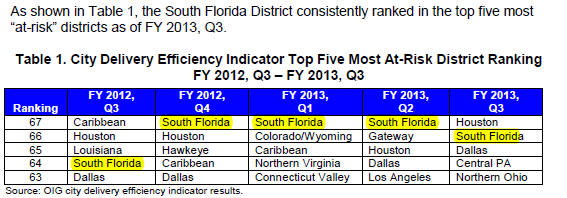USPS Office Of Inspector General’s audit report on “U.S. Postal Service’s City Delivery Efficiency in the South Florida District”
This report presents the results of our self-initiated audit of city delivery efficiency in the South Florida District (Project Number 13XG043DR000). The audit is in response to the U.S. Postal Service Office of Inspector General’s (OIG) City Delivery Efficiency Indicator results used during fiscal year (FY) 2013, which ranked the South Florida District as the second most “at-risk” district, as of FY 2013, Quarter (Q) 3. Our objective was to assess the efficiency of city delivery operations in the South Florida District. [PRnote: Dallas, Houston and the Caribbean Districts are ranked after South Florida]
- USPS OIG graphic via postalreporter.com
City delivery office and street operations cover every duty a letter carrier performs, including sorting and delivering mail, completing paperwork, scanning mail, loading the delivery vehicle, collecting mail along the route, and returning to the delivery unit to unload the delivery vehicle. In FY 2013, South Florida District city letter carriers delivered almost 2.8 billion mailpieces on 4,096 routes to over 2.5 million delivery points. City delivery office and street operational workhours totaled 9,844,953 (see Appendix A for additional information).
The OIG developed a series of interrelated city delivery efficiency indicators at the district level to rank the 67 districts from the most to the least “at risk” for operational and service issues.
Conclusion
The South Florida District has opportunities to enhance efficiency in city delivery operations. We found 83 of 112 delivery units (74 percent) used 374,982 more workhours than projected. This occurred because management did not always enforce policies and procedures for supervising city delivery operations. Also, office and street supervision was inconsistent at the delivery units, allowing for some inefficiency in operations. Officials indicated their office workload priorities limited their ability to monitor carriers delivering mail. We identified the potential to eliminate 374,982 workhours through improved supervision and other efforts. This would increase overall efficiency at these delivery units and avoid about $15 million in costs annually (see Appendix B).
Integrated Operating Plan
Mail did not always arrive on time, or in the proper mail mix. We observed several instances in which the majority of flat mail arrived with DPS mail on the last dispatch of the morning. Further, we observed parcels arriving with DPS mail or arriving later than expected. We also observed managers at most of the units we visited inconsistently used the IOP Discrepancy Report System to report mail arrival issues. Further, in several instances, the delivery units had outdated IOPs. The Postal Service designed the IOP system to help stabilize mail flow and it is critical to establishing appropriate staffing and reporting times to eliminate carrier delays.
Delays can prolong carriers’ return times beyond 5 p.m., which may also contribute to overtime hours. At the delivery units we observed, carriers’ start times began around 9 a.m. or later, which led to carriers returning after 5 p.m. (see Figure 2). Unit managers have met with district officials, via teleconferences, on individual issues, but they have not worked together on comprehensive solutions to late mail arrival, mail out of route order, or other systemic problems.
Inefficient Carrier Practices
The OIG also observed instances of carrier inefficiencies while on office duty. We traced some inefficient loading habits to carriers waiting for mail or parcels and found opportunities for carriers to save office time by preparing mail for delivery and save street time by loading vehicles. We observed time-wasting practices, such as carriers waiting in line for accountable mail, excessive talking on cell phones during mail sorting, and visits to personal vehicles (see Figures 3 and 4).
The OIG also observed instances of carriers being inefficient while on street duty by, for example, going to their personal vehicles and not using satchels (see Figures 5 and 6).
When carriers do not use their satchels to deliver mail, they make multiple trips to and from their vehicles and incur additional street time. Postal Service procedures require carriers delivering mail on park-and-loop routes6 to use their vehicles as movable relay boxes from which they withdraw a substantial amount of mail that they place into their satchels before beginning their routes. Carriers must carry the appropriate amount of mail — up to 35 pounds — to complete each assigned relay without additional trips to the vehicle or relay box.7
Recommendations
We recommend the manager, South Florida District, instruct unit supervisors at delivery units to:
1. Implement efforts to eliminate 374,982 workhours at the delivery units cited.
2. Reinforce and ensure adherence to Postal Service policies and procedures for supervising city delivery operations at delivery units.
3. Eliminate inefficient carrier practices, such as carriers waiting in line for accountable mail, excessive talking on cell phones during mail sorting, and visits to personal vehicles.
4. Increase mail arrival efficiency by preparing integrated operating plans with facility processing managers.
5. Use the Integrated Operating Plan Discrepancy Report System to monitor compliance and identify and correct systemic issues.
6. Ensure delivery point sequence mail arrives timely and in route order for easy retrieval by carriers.
